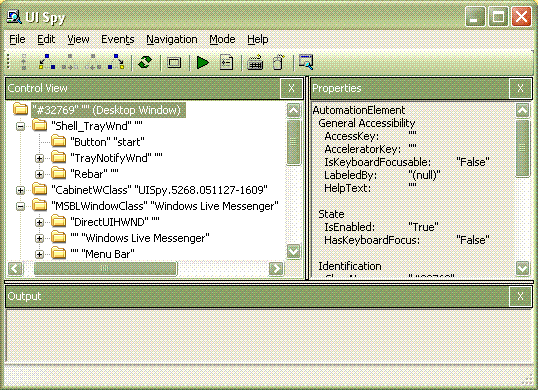Note
Access to this page requires authorization. You can try signing in or changing directories.
Access to this page requires authorization. You can try changing directories.
Note
This documentation is intended for .NET Framework developers who want to use the managed UI Automation classes defined in the System.Windows.Automation namespace. For the latest information about UI Automation, see Windows Automation API: UI Automation.
This topic provides information about UI Automation support for the Pane control type. In UI Automation, a control type is a set of conditions that a control must meet in order to use the ControlTypeProperty property. The conditions include specific guidelines for UI Automation tree structure, UI Automation property values and control patterns.
The Pane control type is used to represent an object within a frame or document window. Users can navigate between pane controls and within the contents of the current pane, but cannot navigate between items in different panes. Thus, pane controls represent a level of grouping lower than windows or documents, but above individual controls. The user navigates between panes by pressing TAB, F6, or CTRL+TAB, depending on the context. No specific keyboard navigation is required by the Pane control type.
The following sections define the required UI Automation tree structure, properties, control patterns, and events for the Pane control type. The UI Automation requirements apply to all list controls, whether Windows Presentation Foundation (WPF), Win32, or Windows Forms.
Required UI Automation Tree Structure
The following table depicts the control view and the content view of the UI Automation tree that pertains to pane controls and describes what can be contained in each view. For more information on the UI Automation tree, see UI Automation Tree Overview.
| Control View | Content View |
|---|---|
| Pane | Pane |
Required UI Automation Properties
The following table lists the UI Automation properties whose value or definition is especially relevant to pane controls. For more information on UI Automation properties, see UI Automation Properties for Clients.
| UI Automation Property | Value | Notes |
|---|---|---|
| AutomationIdProperty | See notes. | The value of this property needs to be unique across all controls in an application. |
| BoundingRectangleProperty | See notes. | The outermost rectangle that contains the whole control. |
| IsKeyboardFocusableProperty | See notes. | If the control can receive keyboard focus, it must support this property. |
| NameProperty | See notes. | The value for this property must always be a clear, concise and meaningful title. |
| ClickablePointProperty | See notes. | This property exposes a clickable point of the pane control that causes the pane to become focused when it is clicked. |
| LabeledByProperty | See notes. | Pane controls typically do not have a static label. If there is a static text label, it should be exposed through this property. |
| ControlTypeProperty | Pane | This value is the same for all UI frameworks. |
| LocalizedControlTypeProperty | "pane" | Localized string corresponding to the Pane control type. |
| IsContentElementProperty | True | Pane controls are always included in the content view of the UI Automation tree. |
| IsControlElementProperty | True | Pane controls are always included in the control view of the UI Automation tree. |
| HelpTextProperty | "" | The help text for pane controls should explain why the purpose of the frame and how it relates to other frames. A description is necessary if the purpose and relationship of frames is not clear from the value of the NameProperty. " |
| AccessKeyProperty | See notes. | If a specific key combination gives focus to the pane then that information should be exposed through this property. |
Required UI Automation Control Patterns
The following table lists the UI Automation control patterns required to be supported by all pane controls. For more information on control patterns, see UI Automation Control Patterns Overview.
| Control Pattern | Support | Notes |
|---|---|---|
| ITransformProvider | Depends | Implement this control pattern if the pane control can be moved, resized, or rotated on the screen. |
| IWindowProvider | Never | If you need to implement this control pattern, your control should be based on the Window control type. |
| IDockProvider | Depends | Implement this control pattern if the pane control can be docked. |
| IScrollProvider | Depends | Implement this control pattern if the pane control can be scrolled. |
Required UI Automation Events
The following table lists the UI Automation events required to be supported by all pane controls. For more information on events, see UI Automation Events Overview.
| UI Automation Event | Support/Value | Notes |
|---|---|---|
| WindowClosedEvent | Never | None |
| WindowOpenedEvent | Never | None |
| AsyncContentLoadedEvent | Required | None |
| BoundingRectangleProperty property-changed event. | Required | None |
| IsOffscreenProperty property-changed event. | Required | None |
| IsEnabledProperty property-changed event. | Required | None |
| HorizontallyScrollableProperty property-changed event. | Depends | None |
| HorizontalScrollPercentProperty property-changed event. | Depends | None |
| HorizontalViewSizeProperty property-changed event. | Depends | None |
| VerticalScrollPercentProperty property-changed event. | Depends | None |
| VerticallyScrollableProperty property-changed event. | Depends | None |
| VerticalViewSizeProperty property-changed event. | Depends | None |
| WindowVisualStateProperty property-changed event. | Never | None |
| AutomationFocusChangedEvent | Required | None |
| StructureChangedEvent | Required | None |
Pane Control Type Example
The following image illustrates a control that implements the Pane control type.

| UI Automation Tree - Control View | UI Automation Tree - Content View |
|---|---|
|
- Pane - Tree (Scroll Pattern) - TreeItem - …Pane - Edit - (Scroll Pattern) |